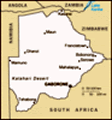Advertisement
Published: November 16th 2011
Botswana has 1.8 million people, a diamond mine, the Kalahari Desert, and 270,000 elephants in Chobe National Park alone. To have a look at the National Park we spent three days at Muchenje Safari Lodge. Getting there from Victoria Falls involved an hour drive to the Zimbabwe-Botswana border, queuing in two hot and stale-smelling immigration offices, then a short ride in the back of a safari vehicle to Kasane and from there another hour along the highway through the park to our lodge.
The lodge is quite nice but certainly isn’t the height of luxury, and the lack of air conditioning was a bit of a drawback when the temperatures got up to 38 or 40 in the days we were there. Unlike our previous safari experience it is also outside the National Park boundary, so there is a bit of an extra drive each time you go game viewing.
From the park entrance gate down to the floodplain, where most of the animals hang around, is quite a drive along a very sandy and very rough track. Vehicles aren’t allowed off the roads in the park, although judging from the tyre tracks this rule is ignored somewhat.
But all the bouncing around and wind in the hair is worth it for the sheer quantity of wildlife in this place. Along with the aforementioned squillion elephants are similar numbers of buffalo, giraffe, zebra, antelope of various breeds and baboons by the score.
We had a sundowner (the African term for beer o’clock, it seems) on a hill overlooking the river, with the plain behind teeming with all kinds of animals and the reddest sunset we have ever seen lending a red-brown hue to the whole scene. If on this trip we have set our eyes on a quintessential African sight this was probably it (the animals, that is, not the esky full of drinks).
The big cats are not so easy to spot in Chobe, so when, on our first afternoon game drive, we got a glimpse of a leopard, we stayed a bit too long trying to follow him. This meant we were in danger of missing the 7 pm park closing time. After a wild, rough, kidney-displacing and probably quite dangerous dash back up the goat track of a road we discovered the gates already closed. Luckily, though, our drivers had a well-constructed (although
probably not very convincing) story of one breaking down and the other two staying behind to help, so we didn’t have to spend our first night sleeping under the stars.
We also noticed, and rather enjoyed, the lack of safety regulations compared to our over-protected existence in a developed nation. We drove at speed along a highway in an open safari vehicle with not a seat belt in sight. Our safety briefing for a boat ride was “Please don’t stand up if the boat is moving fast, and there are drinks at the back here if anybody would like one”.
The boat trip along the river was a highlight. We floated past hippos, elephants and buffalo, and, disturbingly, within about two metres of a number of rather unfriendly-looking crocodiles, all the while being served drinks and more information about the wildlife than we could ever hope to remember.
Because of the numbers of animals, Chobe is full of reminders of the way life works in the wild. There was a hyena feasting on a dead (and very smelly) elephant calf. There was a buffalo dead in the river and, on our last day, a dead elephant on
the floodplain. One of the saddest sights we saw was a female baboon carrying in her mouth the body of her dead baby – they are extremely devoted parents and when a baby dies they cannot bear to part with it.
As if thedickosgapyear needed any reminder of how lucky we are, we were taken for a visit to a local village. Subsistence farmers, but largely supported by members of the extended family who have paying jobs, it was a pretty squalid existence. We bought a trinket from them for a few dollars, which might have made us feel a bit better but didn’t take the scene out of our minds.
A bit more uplifting was the school (retired former teachers look away now – you know who you are). Happy kids, all with uniforms – torn, ragged and smelly as they were – and barely an unhappy face among them, they swarmed around us to have their photos taken and have us write our names for them. It was a positive ending to our brief look at Botswana’s locals, and, since some of these small children walk up to 5 kilometres to and from school, a credit
to the kids and the community.
Back at the lodge, drinking a beer and looking out over the herds on the floodplain, it was all too easy to be captivated by the scenery and forgetful of the poverty. Botswana, a relatively rich country for Africa, seems to have both of these in abundance.
And so our Botswanian excursion ended all too soon, although the move to a cooler climate was more than welcome. We said a fond farewell to some of the very nice people we had met, and moved on to Mauritius, via a night in Jo’burg at the exceedingly tacky Emperor’s Palace Casino complex. More on that in the next post.
Advertisement
Tot: 0.084s; Tpl: 0.014s; cc: 8; qc: 50; dbt: 0.053s; 1; m:domysql w:travelblog (10.17.0.13); sld: 1;
; mem: 1.2mb



















John K
non-member comment
The Journey So far
Chris & Sharon, Great read, looking forward to read the rest of your travels as I am sitting in my dingy little office, where a stingy Ray of sunlight struggles feebly down between the houses tall, And the foetid air and gritty of the dusty, dirty city Through the open window floating, spreads its foulness over all (with apologies to Banjo Paterson